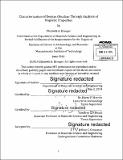Characterization of Kenyan obsidian through analysis of magnetic properties
Author(s)
Krueger, Elizabeth A., S.B. Massachusetts Institute of Technology
DownloadFull printable version (7.500Mb)
Other Contributors
Massachusetts Institute of Technology. Department of Materials Science and Engineering.
Advisor
Harry V. Merrick and Geoffrey S.D. Beach.
Terms of use
Metadata
Show full item recordAbstract
Obsidian is known to have been used for tool making in Kenya since the Early Stone Age, appearing as early as 974 thousand years ago (Durkee and Brown, in press). Past research has shown that the study of obsidian artifacts, and the determination of their provenance, can be very useful in reconstructing past civilizations and analyzing the spread of technology and trade. A number of different analytical techniques have previously been utilized to characterize obsidian sources for such studies, including magnetic analysis. This thesis reports the results of a preliminary study to explore the potential of utilizing magnetic analysis for the characterization of obsidian sources in Kenya. A total of 192 samples from 23 localities, belonging to 6 broadly defined petrologically distinct source groups, were analyzed using a vibrating sample magnetometer to test saturation magnetization (Ms), remanence magnetization (Mr), and coercivity (Hc). Comparing the ratio of Mr/Ms with Hc allowed clear differentiation among three of the analyzed obsidian sources (Groups 14, 19, and 29 from Merrick and Brown 1984a). The magnetic signatures reveal clues about the microscopic Fe mineral grains present in the samples, suggesting that magnetic characterization also has the potential to provide additional value as a supplementary technique to chemical analysis. Based on these preliminary results, it is proposed that future studies could examine the temperature dependence of the magnetic properties of obsidian to provide more complete characterization of the obsidian sources.
Description
Thesis: S.B. in Archaeology and Materials, Massachusetts Institute of Technology, Department of Materials Science and Engineering, 2014. Cataloged from PDF version of thesis. Includes bibliographical references (pages 46-49).
Date issued
2014Department
Massachusetts Institute of Technology. Department of Materials Science and EngineeringPublisher
Massachusetts Institute of Technology
Keywords
Materials Science and Engineering.